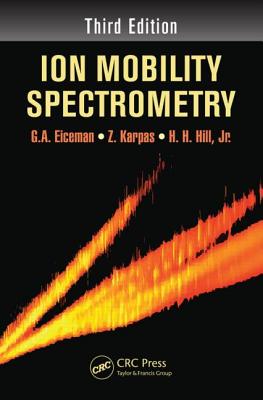Ion Mobility Spectrometry
By:
G.A. Eiceman
(Author)
, G.A. Eiceman
(Author)
, G.A. Eiceman
(Author)
, G.A. Eiceman
(Author)
, G.A. Eiceman
(Author)
, G.A. Eiceman
(Author)
, G.A. Eiceman
(Author)
, G.A. Eiceman
(Author)
, G.A. Eiceman
(Author)
, G.A. Eiceman
(Author)
, G.A. Eiceman
(Author)
, G.A. Eiceman
(Author)
, G.A. Eiceman
(Author)
, G.A. Eiceman
(Author)
, G.A. Eiceman
(Author)
, G.A. Eiceman
(Author)
, G.A. Eiceman
(Author)
, G.A. Eiceman
(Author)
, G.A. Eiceman
(Author)
, G.A. Eiceman
(Author)
, G.A. Eiceman
(Author)
, G.A. Eiceman
(Author)
, G.A. Eiceman
(Author)
, G.A. Eiceman
(Author)
, G.A. Eiceman
(Author)
, G.A. Eiceman
(Author)
, G.A. Eiceman
(Author)
, G.A. Eiceman
(Author)
, G.A. Eiceman
(Author)
, G.A. Eiceman
(Author)
, G.A. Eiceman
(Author)
, G.A. Eiceman
(Author)
, G.A. Eiceman
(Author)
, G.A. Eiceman
(Author)
, G.A. Eiceman
(Author)
, G.A. Eiceman
(Author)
, G.A. Eiceman
(Author)
, G.A. Eiceman
(Author)
, G.A. Eiceman
(Author)
, G.A. Eiceman
(Author)
, G.A. Eiceman
(Author)
, G.A. Eiceman
(Author)
, G.A. Eiceman
(Author)
, G.A. Eiceman
(Author)
, G.A. Eiceman
(Author)
, G.A. Eiceman
(Author)
, G.A. Eiceman
(Author)
, G.A. Eiceman
(Author)
, G.A. Eiceman
(Author)
, Herbert H. Hill Jr.
(Author)
, Herbert H. Hill Jr.
(Author)
, Herbert H. Hill Jr.
(Author)
, Herbert H. Hill Jr.
(Author)
, Herbert H. Hill Jr.
(Author)
, Herbert H. Hill Jr.
(Author)
, Herbert H. Hill Jr.
(Author)
, Herbert H. Hill Jr.
(Author)
, Herbert H. Hill Jr.
(Author)
, Herbert H. Hill Jr.
(Author)
, Herbert H. Hill Jr.
(Author)
, Herbert H. Hill Jr.
(Author)
, Herbert H. Hill Jr.
(Author)
, Herbert H. Hill Jr.
(Author)
, Herbert H. Hill Jr.
(Author)
, Herbert H. Hill Jr.
(Author)
, Herbert H. Hill Jr.
(Author)
, Herbert H. Hill Jr.
(Author)
, Herbert H. Hill Jr.
(Author)
, Herbert H. Hill Jr.
(Author)
, Herbert H. Hill Jr.
(Author)
, Herbert H. Hill Jr.
(Author)
, Herbert H. Hill Jr.
(Author)
, Herbert H. Hill Jr.
(Author)
, Herbert H. Hill Jr.
(Author)
, Herbert H. Hill Jr.
(Author)
, Herbert H. Hill Jr.
(Author)
, Herbert H. Hill Jr.
(Author)
, Herbert H. Hill Jr.
(Author)
, Herbert H. Hill Jr.
(Author)
, Herbert H. Hill Jr.
(Author)
, Herbert H. Hill Jr.
(Author)
, Herbert H. Hill Jr.
(Author)
, Herbert H. Hill Jr.
(Author)
, Herbert H. Hill Jr.
(Author)
, Herbert H. Hill Jr.
(Author)
, Herbert H. Hill Jr.
(Author)
, Herbert H. Hill Jr.
(Author)
, Herbert H. Hill Jr.
(Author)
, Herbert H. Hill Jr.
(Author)
, Herbert H. Hill Jr.
(Author)
, Herbert H. Hill Jr.
(Author)
, Herbert H. Hill Jr.
(Author)
, Herbert H. Hill Jr.
(Author)
, Herbert H. Hill Jr.
(Author)
, Herbert H. Hill Jr.
(Author)
, Herbert H. Hill Jr.
(Author)
, Herbert H. Hill Jr.
(Author)
, Herbert H. Hill Jr.
(Author)
, Z. Karpas
(Author)
, Z. Karpas
(Author)
, Z. Karpas
(Author)
, Z. Karpas
(Author)
, Z. Karpas
(Author)
, Z. Karpas
(Author)
, Z. Karpas
(Author)
, Z. Karpas
(Author)
, Z. Karpas
(Author)
, Z. Karpas
(Author)
, Z. Karpas
(Author)
, Z. Karpas
(Author)
, Z. Karpas
(Author)
, Z. Karpas
(Author)
, Z. Karpas
(Author)
, Z. Karpas
(Author)
, Z. Karpas
(Author)
, Z. Karpas
(Author)
, Z. Karpas
(Author)
, Z. Karpas
(Author)
, Z. Karpas
(Author)
, Z. Karpas
(Author)
, Z. Karpas
(Author)
, Z. Karpas
(Author)
, Z. Karpas
(Author)
, Z. Karpas
(Author)
, Z. Karpas
(Author)
, Z. Karpas
(Author)
, Z. Karpas
(Author)
, Z. Karpas
(Author)
, Z. Karpas
(Author)
, Z. Karpas
(Author)
, Z. Karpas
(Author)
, Z. Karpas
(Author)
, Z. Karpas
(Author)
, Z. Karpas
(Author)
, Z. Karpas
(Author)
, Z. Karpas
(Author)
, Z. Karpas
(Author)
, Z. Karpas
(Author)
, Z. Karpas
(Author)
, Z. Karpas
(Author)
, Z. Karpas
(Author)
, Z. Karpas
(Author)
, Z. Karpas
(Author)
, Z. Karpas
(Author)
, Z. Karpas
(Author)
, Z. Karpas
(Author)
, Z. Karpas
(Author)
Out of stock
Ksh 48,150.00
 Jacket, Women
Jacket, Women
 Woolend Jacket
Woolend Jacket
 Western denim
Western denim
 Mini Dresss
Mini Dresss
 Jacket, Women
Jacket, Women
 Woolend Jacket
Woolend Jacket
 Western denim
Western denim
 Mini Dresss
Mini Dresss
 Jacket, Women
Jacket, Women
 Woolend Jacket
Woolend Jacket
 Western denim
Western denim
 Mini Dresss
Mini Dresss
 Jacket, Women
Jacket, Women
 Woolend Jacket
Woolend Jacket
 Western denim
Western denim
 Mini Dresss
Mini Dresss
 Jacket, Women
Jacket, Women
 Woolend Jacket
Woolend Jacket
 Western denim
Western denim
 Mini Dresss
Mini Dresss














































